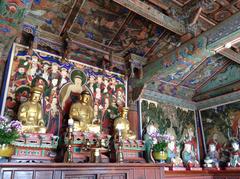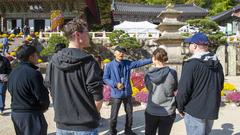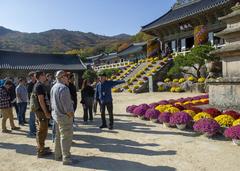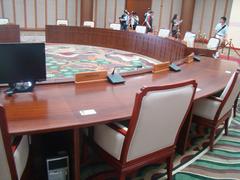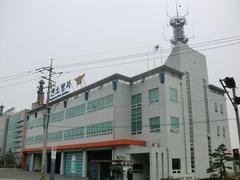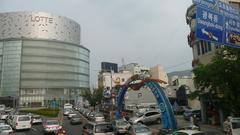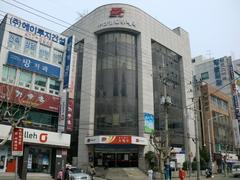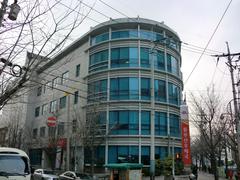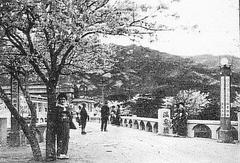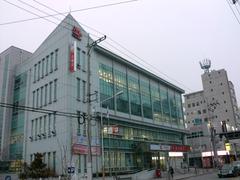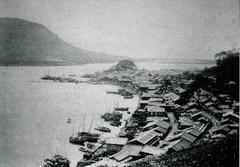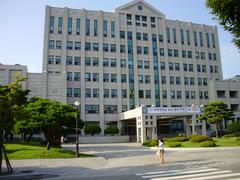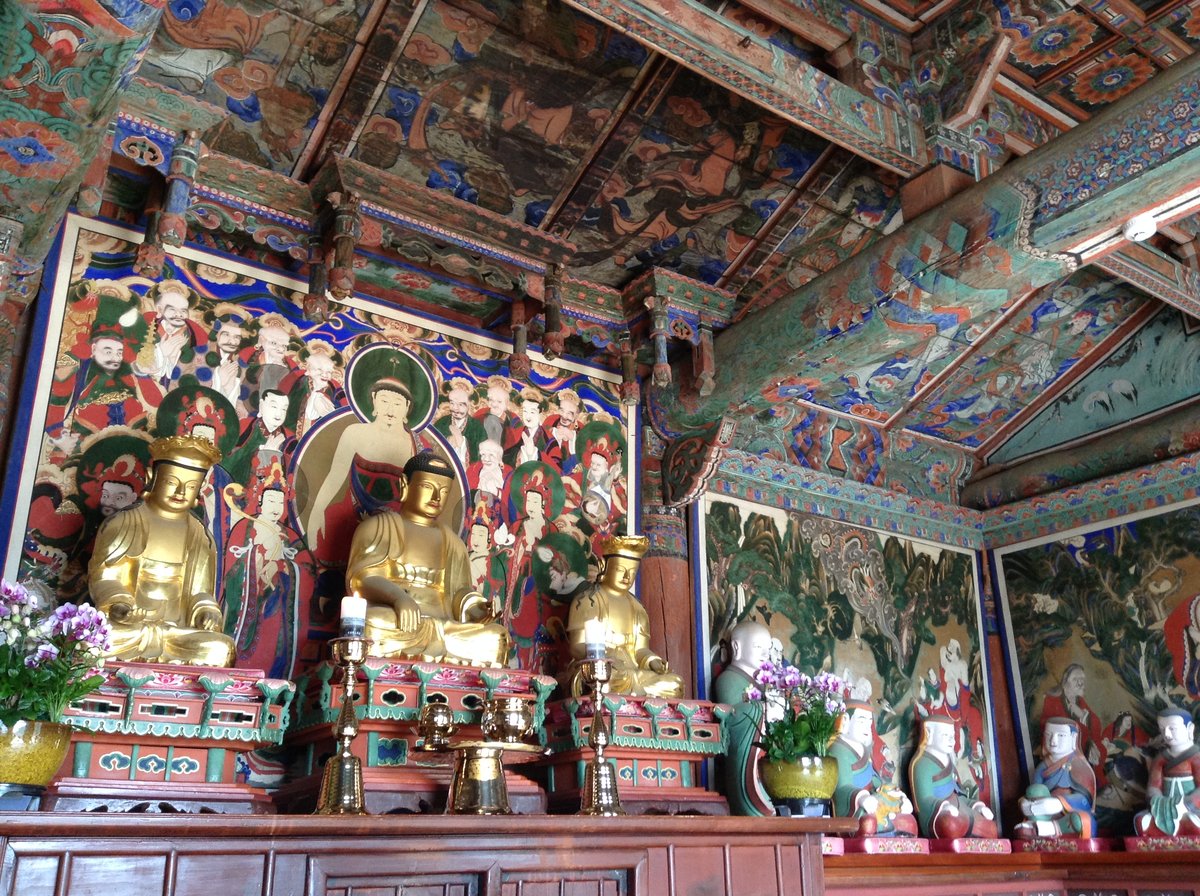
Beomeosa Temple: Visiting Hours, Tickets, and Complete Guide to Busan’s Historical Gem
Date: 14/06/2025
Introduction: Discovering Beomeosa Temple and Its Cultural Significance
Beomeosa Temple, gracefully positioned on the slopes of Mt. Geumjeongsan in Busan, South Korea, stands as an enduring symbol of the nation’s Buddhist heritage and architectural prowess. Established in 678 AD during the Silla Dynasty by the revered monk Uisang-daesa, Beomeosa—meaning “Temple of the Nirvana Fish”—is intricately linked with local legend, including the story of a golden fish descending from the heavens to a mystical, ever-flowing well (Korean Temple Guide, Travelexx). Through centuries marked by destruction and rebirth, especially post-16th century invasions, the temple today exemplifies resilience, spirituality, and cultural continuity. As one of Korea’s major monastic training centers under the Jogye Order, Beomeosa is a vibrant focal point for spiritual practice, immersive cultural experiences, and natural beauty—making it a must-visit for travelers to Busan (Klook, TravelSetu).
Table of Contents
- Historical Overview
- Architectural & Artistic Highlights
- Spiritual Life and Templestay Programs
- Visitor Information
- Nature & Best Seasons for Visiting
- Photography Spots & Panoramic Views
- Things to Do & Nearby Attractions
- FAQs
- Conclusion & Recommendations
- References
Historical Overview of Beomeosa Temple
Founding and Early History
Beomeosa was founded in 678 AD by Uisang-daesa, a leading figure in Korean Buddhism, as part of the Silla Kingdom’s commitment to Buddhist expansion (Korean Temple Guide). The temple’s name and location stem from the legend of a heavenly golden fish, bestowing spiritual energy upon the mountain and the temple’s sacred well.
Medieval Period and Rebuilding
Flourishing through the Goryeo and early Joseon dynasties, Beomeosa became a regional hub for Buddhist study and practice. The original structures were decimated during the Imjin War (1592–1598), but extensive reconstruction began in 1613, restoring the temple’s significance (Remotelands).
Architectural Heritage and Notable Artifacts
Key rebuilt structures include:
- Daeungjeon (Main Hall): Finished in 1614, renowned for its wooden carvings and dancheong painting (Klook).
- Iljumun (One Pillar Gate): The iconic entrance symbolizing the singular path to enlightenment.
- Three-story Stone Pagoda: A Silla-era relic, National Treasure No. 250, exemplifying ancient stonework (Veronika’s Adventure).
- Beomeosa Bell: A massive bronze bell from the Joseon period, recognized as a national treasure.
Cultural and Religious Significance
Beomeosa is a leading center for Seon (Zen) Buddhism and one of the Jogye Order’s eight monastic training centers. The temple complex includes numerous hermitages and is a venue for significant rituals and festivals, ensuring its continued role as both a religious and cultural landmark (Korean Temple Guide).
Colonial Era and Modern Preservation
During Japanese occupation (1910–1945), Beomeosa’s narrative was altered for colonial purposes (Korean Temple Guide). Post-war restoration and government initiatives have established it as a symbol of cultural resilience and a core tourism site (TravelSetu).
Architectural & Artistic Highlights
- Iljumun (One Pillar Gate): Marks the threshold from the secular to the sacred, famous for its symbolic structure (Klook).
- Daeungjeon (Main Hall): Spiritual heart of the temple, adorned with Buddhist statues and murals.
- Cheongwangmun (Gate of the Four Heavenly Kings): Houses guardians that protect the temple.
- Three-story Stone Pagoda: Unified Silla period, pivotal for prayer and meditation.
- Hermitages & Pavilions: Eleven hermitages and serene pavilions scattered across the forested grounds.
- Wisteria Woods & Valleys: Designated natural monument, especially beautiful in May (Hipfig).
Decorative features like dancheong, carved beams, and stone lanterns showcase centuries of Korean Buddhist artistry.
Spiritual Life and Templestay Programs
Rituals and Festivals
- Buddha’s Birthday: Celebrated with lantern festivals, processions, and prayers (TravelSetu).
- Chuseok: Marked by ancestral rites and Buddhist ceremonies.
Monastic Life & Temple Stay
Beomeosa offers immersive temple stay programs (typically on weekends, bookable via the official Templestay website), which include:
- Meditation and chanting sessions
- Traditional tea ceremonies
- Craft activities (e.g., bracelet making)
- Mindful walking and nature trails
- Sunmudo martial arts demonstrations (Hipfig)
Accommodations are basic, vegetarian meals are provided, and participants follow monastic schedules for a true spiritual retreat.
Visitor Information
Visiting Hours & Admission
- Hours: Open daily, generally from 6:00 AM to 6:00 PM. Some seasonal variation; check ahead for special events (Klook, afreesoulabroad.com).
- Admission: Entry to temple grounds is free. Fees apply for temple stay programs and special tours.
Accessibility
- Mobility: Main paths are paved and partially wheelchair accessible; some areas have stairs and uneven ground.
- Restrooms: Accessible facilities available near the entrance.
- Assistance: Contact staff ahead if additional help is required.
Etiquette and Dress Code
- Dress modestly in subdued colors; cover shoulders and knees.
- Remove shoes before entering temple buildings.
- Stay quiet and avoid disruptive behavior; respect ongoing ceremonies.
- Photography outdoors is permitted, but ask before taking photos inside or during rituals.
- No smoking or alcohol.
Facilities
- Restrooms, a small gift shop, tea café, and an information center (with English materials) available near the entrance.
How to Get There
- By Metro: Take Busan Metro Line 1 to Beomeosa Station (Exit 5 or 7), then bus 90 or a short taxi ride to the temple parking lot (cestee.com).
- By Bus: Bus 90 from Beomeosa Station stops near the temple entrance.
- By Taxi: Direct from the subway or city center.
- By Foot: Enjoy a scenic 20–30 minute forested walk from the subway station (Klook).
Travel time from downtown Busan: 60–80 minutes depending on traffic.
Nature & Best Seasons to Visit
- Spring (April–May): Wisteria and cherry blossoms create a pastel canopy.
- Autumn (October–November): Fiery foliage and crisp mountain air.
- Winter: Snow-dusted tranquility.
- Early mornings and weekdays offer the most peaceful experiences (Trip.com).
Photography Spots & Panoramic Views
- Iljumun Gate: Dramatic at sunrise, framed by ancient trees.
- Three-story Pagoda: With Geumjeongsan peaks as backdrop.
- Main Courtyard: During cherry blossom or autumn foliage.
- Hiking Trails: Offer sweeping views of Busan and the mountains.
Things to Do & Nearby Attractions
- Guided temple tours for in-depth historical and architectural insights (travelsetu.com).
- Participate in festivals such as Buddha’s Birthday.
- Hiking on Geumjeongsan Mountain: Multiple trails for all skill levels.
- Nearby Sites: Gamcheon Culture Village, Haeundae Beach, Jagalchi Fish Market, and other major temples (Tongdosa, Haeinsa).
Frequently Asked Questions (FAQ)
Q: What are Beomeosa Temple’s visiting hours?
A: Generally, 6:00 AM–6:00 PM daily. Hours can vary by season or event.
Q: Is there an admission fee?
A: Entry to temple grounds is free; special programs and guided tours require a fee.
Q: How do I get there from Busan city center?
A: Metro Line 1 to Beomeosa Station, then bus 90, taxi, or a 20–30 minute walk.
Q: Is Beomeosa accessible for visitors with disabilities?
A: Main paths are accessible; some areas have stairs and uneven terrain.
Q: Can I join a temple stay?
A: Yes, book through the official Templestay website. Programs run most weekends.
Q: Are guided tours available?
A: Yes, check with the temple or local agencies for availability.
Q: Is photography allowed?
A: Outdoors, yes. For indoor areas or ceremonies, ask or check signage.
Conclusion & Recommendations
Beomeosa Temple is a cornerstone of Busan’s spiritual and historical landscape, perfectly harmonizing ancient Buddhist traditions with living culture and breathtaking mountain scenery. Whether you’re seeking historical depth, a spiritual retreat, or an escape into nature, Beomeosa delivers a memorable experience. For the best visit, plan during seasonal highlights or festivals, respect local customs, and consider joining a temple stay for immersive insight into Korean Buddhist life.
Download the Audiala app for audio guides, interactive maps, and up-to-date travel tips about Beomeosa Temple and other Busan attractions. For further information, consult the official Beomeosa Temple page and the Korean Temple Stay website.
References
- Beomeosa Temple – Korean Temple Guide
- Beomeosa Temple Hiking – Travelexx
- Beomeosa Temple – Klook
- Practical Visitor Information – cestee.com
- 15 South Korea’s Most Fascinating Temples – afreesoulabroad.com
- Beomeosa Temple Tourism – TravelSetu
- History of Busan – Veronika’s Adventure
- Beomeosa Busan’s Temple of Fighting Monks – Remotelands
- Beomeosa Temple – Hipfig
- Trip.com Moments – Beomeosa
- A Monk’s Brew – trippytraveller.com
- Busan Historical Sites
- Korean Temple Stays
